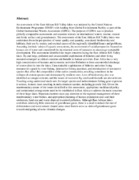| dc.description.abstract | An assessment of the East African Rift Valley lakes was initiated by the United Nations Environment Programme (UNEP) with funding from Global Environment Facility as part of the Global International Waters Assessment (GIWA). The purpose of GIWA was to produce globally comparable assessments and examine stresses on international waters: marine, coastal and fresh; surface and groundwaters. The assessment of the East African Rift Valley lakes was undertaken from the perspective of water quality and quantity, associated biodiversity and habitats, their use by society and societal causes of the regionally identified issues and problems. Assuming intrinsic values of aquatic ecosystems, the assessment of social perspective focused on human use of water and considered the incremental costs of measures to encourage sustainable development. The assessment identified the major concerns facing the East African Rift Valley lakes.
By and large, pollution and unsustainable exploitation of fisheries and other living resources emerged as critical concerns attributable to human activities. East Africa has a very high concentration of humans and economic activities. Pollution is from uncontrolled discharge of wastes directly into the lakes. Unsustainable exploitation of fisheries and other living resources is caused by over-fishing, destructive fishing practices, and introduction of non-native species that affect the composition of the native communities, resulting sometimes in the collapse of certain species and dominance by resilient ones. Loss of biodiversity also was identified as a major concern; and the issues of excessive by-catch and discards are also relevant. Trawling using undersized mesh-nets for target species and indiscriminate fishing gear or poison is serious, in most cases resulting in indiscriminate catches, including juvenile fish. Given the transboundary nature of the issues identified in this assessment, appropriate multilateral policy and institutional arrangements need to be established in East Africa to address the main concerns of these large lakes. Riparian countries must pay attention to the regional management of these transboundary water bodies, and appropriate planning of human population sizes and their settlement, land-use and waste disposal to control pollution. Although East African lakes contribute relatively little emission of greenhouse gases, there is a need to reduce the rate of deforestation and even restore cleared areas since forests serve as sinks of greenhouse gases towards mitigating adverse climatic changes. | en_US |
| dc.subject | Rift Valley lakes, pollution, over-exploitation, habitat modification, biodiversity loss, transboundary diagnostic analysis, causal chain analysis, policy options | en_US |
